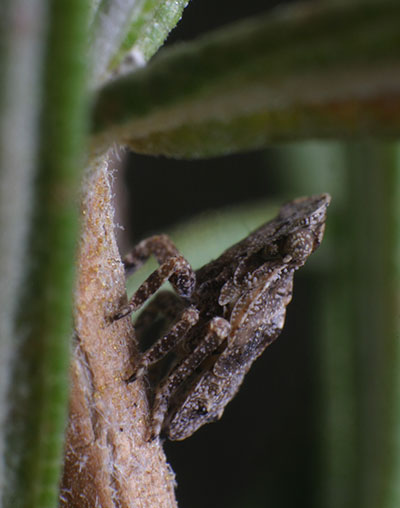 Shocked as I am to report it, the calendar event of the vernal equinox and the weather coincided quite well – the skies cleared and the temperature got into the twenties (or the seventies, if you prefer,) so I did indeed get out to chase a few spring subjects. It was exceedingly few – it’s still a little early for spring in North Carolina, and more so with the temperature fluctuations we’ve had this year, but there were a couple of things to be found. The most interesting one is shown here, having attracted my attention by waggling when I was doing a close examination of the rosemary bush for the resident green lynx spiders. If it had held still I would have missed it easily, since it’s but a few millimeters long and wonderfully camouflaged as a dried rosemary leaf. I have yet to identify this, other than as a ‘leafhopper,’ which really doesn’t narrow things down too much, but I can at least pronounce it a juvenile, due to the undeveloped wings.
Shocked as I am to report it, the calendar event of the vernal equinox and the weather coincided quite well – the skies cleared and the temperature got into the twenties (or the seventies, if you prefer,) so I did indeed get out to chase a few spring subjects. It was exceedingly few – it’s still a little early for spring in North Carolina, and more so with the temperature fluctuations we’ve had this year, but there were a couple of things to be found. The most interesting one is shown here, having attracted my attention by waggling when I was doing a close examination of the rosemary bush for the resident green lynx spiders. If it had held still I would have missed it easily, since it’s but a few millimeters long and wonderfully camouflaged as a dried rosemary leaf. I have yet to identify this, other than as a ‘leafhopper,’ which really doesn’t narrow things down too much, but I can at least pronounce it a juvenile, due to the undeveloped wings.
My model here was reluctant to hold still, or even remain out in the open, so I have few really detailed images. It possesses a few physical traits to remind me of a jagged ambush bug – it has several elaborate flourishes in its chitin, including a lower ‘face’ plate that looks like it’s intended to prevent rocks from striking the oil pan – but the proboscis leads visibly well back under the abdomen like a typical leafhopper and those legs are positioned more for jumping than grasping, so I doubt this is a predatory specimen.
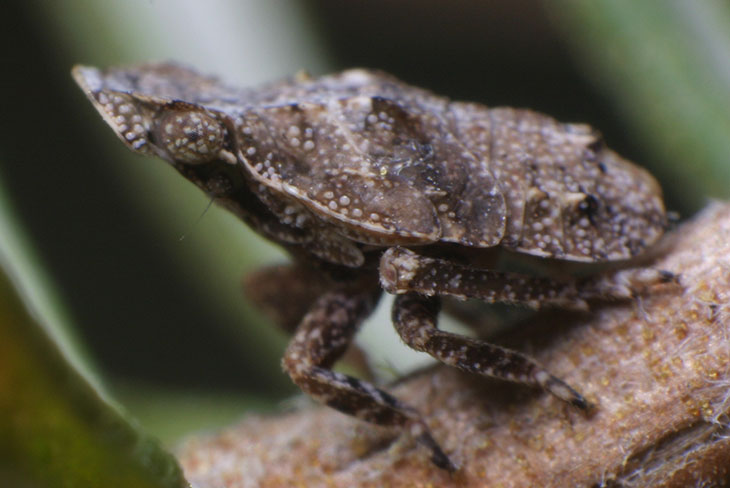
Here’s a slightly better look. The dark plate on the back about midway along the body will later develop into wings, and below/behind the well-camouflaged eye you can see the typical leafhopper antenna – interestingly, it has a groove immediately behind that it can fold into, something that the ambush bug has as well. In some of my images, those whitish spheres along the edge of the body don’t actually look attached, but more like pollen that it’s been nosing through – or, perhaps, globules of rosemary oil that the leaves exude, which makes even casual handling an aromatic experience.
 I discovered the evidence of a recent molt, likely today’s, on the underside of a nearby rosemary leaf. The image below illustrates the scale fairly well, since that’s my fingertip in the background, but also visible are the white spheres that can be found on the leaves – whether these really are what decorates the leafhopper, or its camouflage just resembles this, I am unable to say. Just full of info today, aren’t I?
I discovered the evidence of a recent molt, likely today’s, on the underside of a nearby rosemary leaf. The image below illustrates the scale fairly well, since that’s my fingertip in the background, but also visible are the white spheres that can be found on the leaves – whether these really are what decorates the leafhopper, or its camouflage just resembles this, I am unable to say. Just full of info today, aren’t I?
Scrounging around in the yard, I found a few other examples of insect life, but nothing too exciting – some woodlice and centipedes under rocks where they could gather a little heat from sunlight absorption, a couple of early colonies of ants, and the same (I’m almost certain) black widow that I photographed last year, significantly larger in girth and likely to produce an egg sac soon. She has a nice protected shelter underneath a wooden box that no one is likely to mess with, and I’m inclined to let her remain there, even with impending young that will spread out on their own. Black widows (in this case the southern variant, Latrodectus mactans) like dark, quiet nooks, and just about the only place they could find like this is the crawlspace under the house that no one ever goes into. This species has lived in the area for a long time, and wiping out her or her egg sac really won’t make any difference. Moreover, I’m the only one who ever gets into the habitats they like, and I’m well aware of the possibility of running into them and fine with it. It is a considerably lower risk than fucking with your phone while driving.
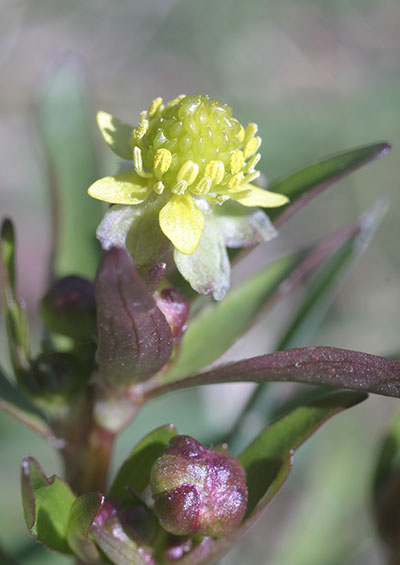 Just for the counterpoint, I sought out the aconite flower that I’d photographed encased in ice only three days ago, none the worse for wear it would appear. This (and the other images soon to follow) represents barely visible color in the yard, which is primary dormant grass, mud, and the sporadic patches of wild onions. With little growing, the rain and melted ice doesn’t get soaked up by anything and the ground is like a sodden towel – I use ground pads at this time of year to do low-level photography, because I’d get sopping wet otherwise.
Just for the counterpoint, I sought out the aconite flower that I’d photographed encased in ice only three days ago, none the worse for wear it would appear. This (and the other images soon to follow) represents barely visible color in the yard, which is primary dormant grass, mud, and the sporadic patches of wild onions. With little growing, the rain and melted ice doesn’t get soaked up by anything and the ground is like a sodden towel – I use ground pads at this time of year to do low-level photography, because I’d get sopping wet otherwise.
In fact, let me segue off into a side topic while here. In the yard, I use carpet tiles to toss down, since they’re about 60cm square and have a durable, waterproof rubber backing, but these are way too bulky to carry around in the field. There, I use carpenter’s kneepads or a small auto floor mat, a thin square of polyethylene (or something – plastic, anyway) that rolls up tight enough to either wrap around a tripod leg or stuff into the pocket of cargo pants. What I really need are waterproof pants, but even I will only go so goofy looking – not to mention that everything I’ve ever seen makes more noise than bubble wrap in a daycare center. I suppose I could always check out those latex bodysuits that are available in, um, ‘specialty’ shops, but what would probably work best is cutting up the ground pieces from an old camping tent. While not as durable as a floor mat, they’d be considerably easier to carry around.
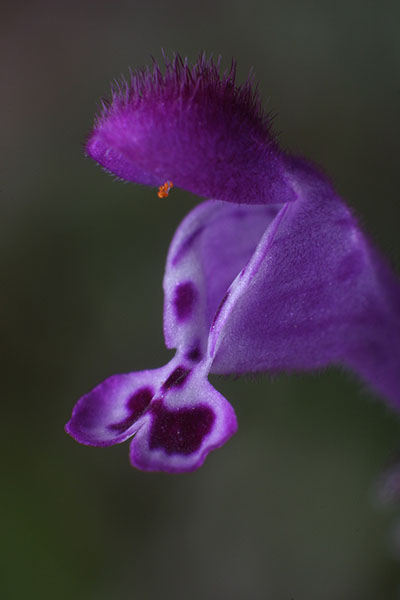 I don’t think the red dead-nettle (Lamium purpureum,) among the first plants up in the spring, copes well with repeated freezes, since it’s barely making an appearance this year – this is one of the very few examples to be found throughout the yard. But it seems to be amused anyway…
I don’t think the red dead-nettle (Lamium purpureum,) among the first plants up in the spring, copes well with repeated freezes, since it’s barely making an appearance this year – this is one of the very few examples to be found throughout the yard. But it seems to be amused anyway…
(Okay, I doubt anyone has gotten the same impression that I have, so I’m going to illustrate it for you and then you won’t be able to get it out of your mind. Not only does this look like an open, braying mouth, but the orange pollen head up there reminds me irresistibly of buck teeth – turning this into the classic depiction of a country yokel, hyuk hyuk hyuk. I apologize for doing that, but add that this is typed in a very insincere way and you can tell that I’m not sorry at all.)
I often wonder what pollinates these early bloomers, since I can only occasionally spot a flying insect whenever these appear each year. I used to think, for instance, that daffodils were wind-pollinated, but it seems very few flowers actually do this. It also stands to reason that those that do would gain no benefit from bright colors, scents, or nectar of any kind. With this inviting alleyway and the pollen head positioned to anoint the back of a foraging insect, it’s obvious that something must perform the spread of genetic material for these flowers – I’ve just never seen what. I could always stake out the blooms until I see the culprit, but I’m afraid my curiosity will not demand that much patience – it’s not exactly a burning question.
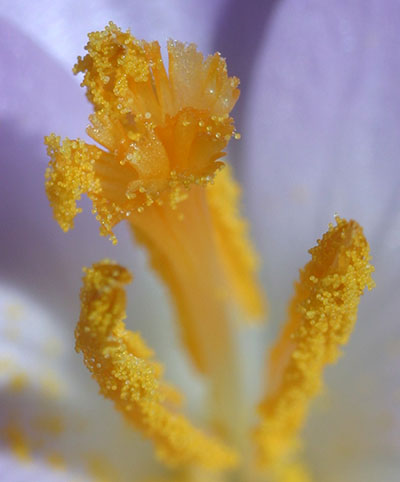 I close with a tight macro shot of The Girlfriend’s Younger Sprog’s crocus, which I may try to get out tomorrow morning and make another attempt at an opening sequence. I just happened to like the detail of the pollen, but I can’t even tell you why. Maybe it has something to do with being a hue that we’re naturally attracted to. Perhaps I have bee genes, though I don’t recall coming back inside and doing a little dance after finding these, so probably not (I’ll let you try to get that image out of your head as well.)
I close with a tight macro shot of The Girlfriend’s Younger Sprog’s crocus, which I may try to get out tomorrow morning and make another attempt at an opening sequence. I just happened to like the detail of the pollen, but I can’t even tell you why. Maybe it has something to do with being a hue that we’re naturally attracted to. Perhaps I have bee genes, though I don’t recall coming back inside and doing a little dance after finding these, so probably not (I’ll let you try to get that image out of your head as well.)
In any event, I’m trying to make the most of it, because the cold weather is forecast to return in just a few days. The flowers are coping with this better than I am, I suspect…




















































